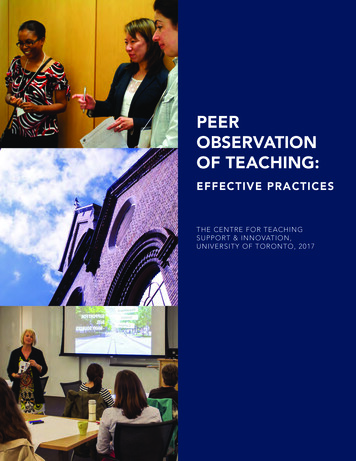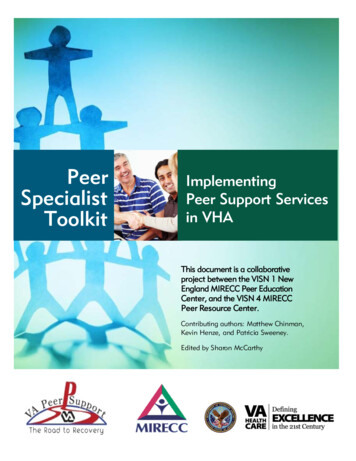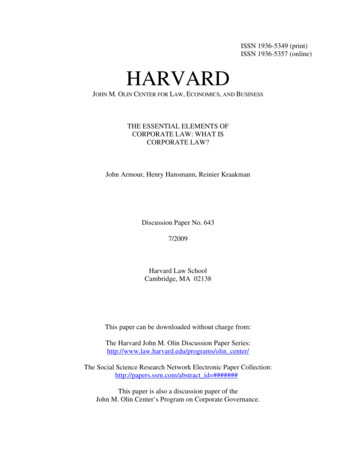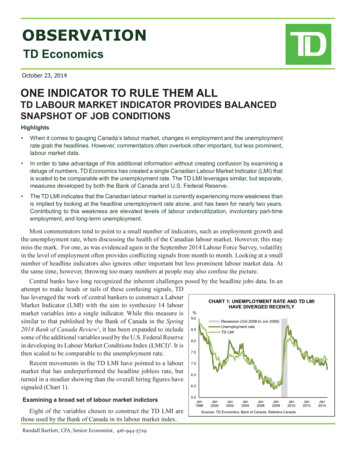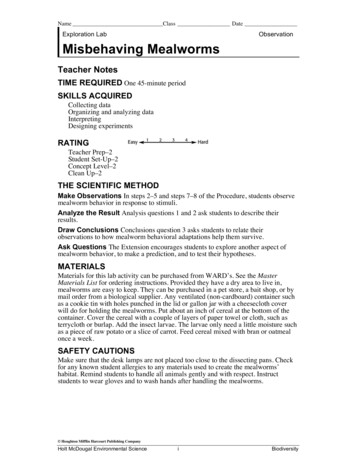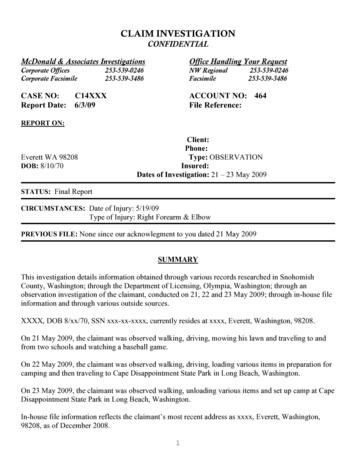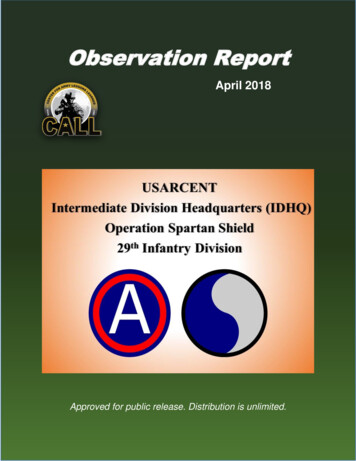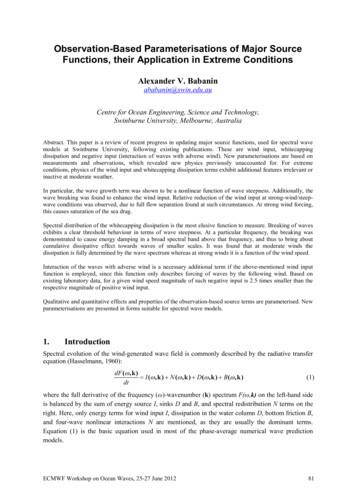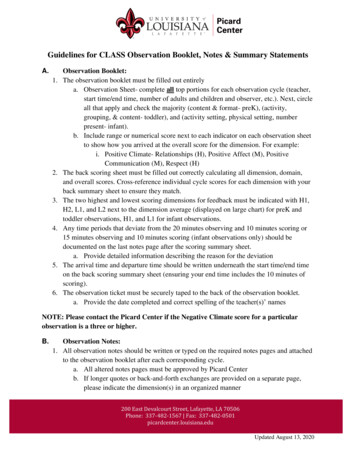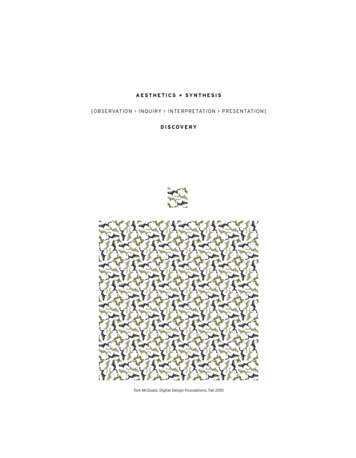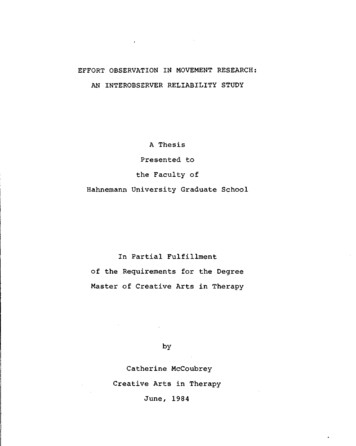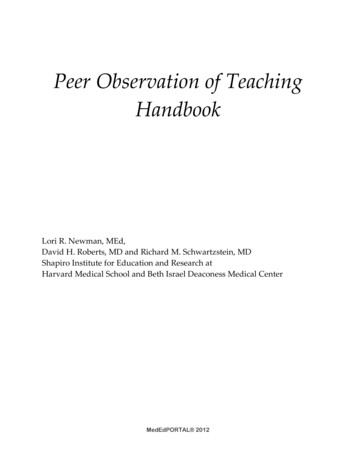
Transcription
Peer Observation of TeachingHandbookLori R. Newman, MEd,David H. Roberts, MD and Richard M. Schwartzstein, MDShapiro Institute for Education and Research atHarvard Medical School and Beth Israel Deaconess Medical CenterMedEdPORTAL 2012
MedEdPORTAL PublicationMedEdPORTAL PublicationPublication Title:Peer Observation of Teaching HandbookPublication ID:MedEdPORTAL ID#: 9150Publication Citation:Newman L, Roberts D, Schwartzstein. Peer Observation of Teaching Handbook.MedEdPORTAL; 2012. Available from: www.mededportal.org/publication/9150Publication Copyright License & Usage a/3.0/Publication Peer-Review Status:MedEdPORTAL (www.mededportal.org) is a free online peer-reviewed publication service provided by theAssociation of American Medical Colleges (AAMC). MedEdPORTAL promotes educational collaboration byfacilitating the open exchange of peer-reviewed teaching resources such as tutorials, virtual patients, simulationcases, lab guides, videos, podcasts, assessment tools, etc. While MedEdPORTAL’s primary audiences includehealth educators and learners around the globe, it is open and available for free to the general public.All third-party copyrighted materials and patient privacy issues are addressed during the review process so userscan download and utilize any and all of the published resources for educational purposes without legalinfringements.MedEdPORTAL 2012MedEdPORTAL: www.mededportal.org
1IntroductionPeer observation of teaching enables professional medical educators to:- connect with their colleagues in collaborative working relationships,- reflect and gain insight on their instructional skills, and- engage in public discourse about best teaching practices.Peer observation may occur as an informal exercise in which faculty members“buddy up” to observe each other teach and discuss what happened during a singleteaching encounter, or as a formal assessment that is part of a larger evaluationsystem. Most often, peer observation occurs as a semi‐structured activity in whichfaculty, with some prior training, are invited to observe a colleague’s teachingsession. The observer may or may not use a teaching observation form to guide theobservation; however, there is always a discussion afterwards to share feedback andexchange ideas about educational strategies, learner engagement, group dynamics,and time management.This handbook describes the steps a peer observer should follow, based on ourexperience and review of the literature, to effectively observe a peer teach and toprovide meaningful feedback. We believe the goals of any peer observation ofteaching experience, whether formal or informal, are the exchange of instructionalinsights, discussion of pedagogical methods, and the development of collaborativeteaching relationships.Notations:- For the purposes of this handbook, we define “peer observer” as the individualconducting the teaching observation, and “faculty member” as the individualbeing observed.-While our published research has focused on medical lecturing, this handbook ismeant to serve as a guide for observation of a variety of teaching activities (fromsmall group discussion to bedside teaching).MedEdPORTAL 2012Developed by the Shapiro Institute for Education and Research at HMS and BIDMC
2Step 1: Clarify expectations:When a faculty member invites you to conduct a peer observation of his orher teaching, begin by determining the goals for the observation. Clarify thatyou will conduct a formative assessment of teaching* directed toward areasthe faculty member identifies as important and in need of improvement. Besure to stress that the observation results and discussion will be confidentialand provided only to the faculty member being observed. Any written notesor documentation will not be shared with supervisory staff unless the facultymember so chooses.*A summative assessment is one component of a formal teachingevaluation process, used for academic or promotional purposes. At ourinstitution, summative teaching assessment is separate from what wedescribe in this handbook. We recommend that prior to summativeteaching assessment, a faculty member have at least two formativeassessments.Step 2: Review logisticsPrior to the observation, you should note the exact date, time, and place of theteaching session, as well as where you can meet the faculty member beforethe session. Schedule enough time to arrive early and stay until the lastlearner has left. Many teaching interactions happen before and after a session,providing you with further insight into the faculty member’s teachingapproach.Take note of the level of learners, the nature of the teaching activity, and theformat of the session. You may also want to look at the curriculum, courseoutline, or any assigned readings. Ask the faculty member what has beentaught previously and what will be taught in subsequent sessions (ifappropriate) to help you place this session into an educational context.Although this may seem minor, it is important to determine how the facultymember will introduce you to the learners (if you are not introduced to thelearners, they may assume you are observing them!)MedEdPORTAL 2012Developed by the Shapiro Institute for Education and Research at HMS and BIDMC
3Finally, ensure that there is adequate time after the teaching session to debriefthe experience and provide feedback, or arrange a meeting soon thereafter forthis purpose.Step 3: Plan the feedback meeting firstPrior to the session, schedule a time when you will meet to discuss yourreflections and feedback with the faculty member. The feedback discussion isan essential component of conducting an observation; therefore, scheduling afeedback meeting should be as high a priority as scheduling the observation.In addition to a face‐to‐face discussion, it may also be useful for the facultymember to receive written documentation of your observations, ideas, andsuggestions. Note that all comments will be kept in strict confidence.Step 4: Focus the lensSpeak with the faculty member before the session to review his/her goals forthe teaching encounter. What does the faculty member expect the learners toknow, show, or do by the end of the session? Are there specific learningscenarios that he/she has struggled with prior to this session? By identifyingspecific teaching skills on which you should focus your attention during theobservation, you will be able to provide valuable and meaningful feedback tothe faculty member after the teaching session.To help the faculty member identify specific teaching skills and behaviors onwhich he or she would like you to focus during the teaching encounter, youmight start by reviewing a peer teaching observation form. Without a list ofteaching behaviors, faculty members often have trouble pinpointing the exactarea or skill they would like to improve. There are numerous teachingobservation forms published in the medical education literature and availableon the Internet. At the end of this handbook, we have included a collection ofpeer observation of teaching forms that we have created to help guide peerobservation at our institution. We encourage you to use and adapt theseforms to meet your own peer observation needs. We have also included apeer observation of lecturing assessment form that we previously created,validated, and published.11Newman LR, Lown BA, Jones RN, Johansson A, Schwartzstein RM. Developing a peer assessment of lecturinginstrument: Lessons learned. Academic Medicine. 2009; 84:1104-1110.MedEdPORTAL 2012Developed by the Shapiro Institute for Education and Research at HMS and BIDMC
4Step 5: Conduct the observationTo capture what happens during the teaching session it is best to take copiousnotes about the learning environment, learner engagement, teachingmethods, and management of the session. You might bring a peer observationteaching form with you; however, it is difficult to attend to what is happeningin the classroom while considering each item listed on the form. Rememberthe form’s purpose is to guide the observation, not to rate or assess a teachingperformance. It is best to review the form ahead of time, bring it with you,and then take notes on its backside. Later, with the faculty member, you canlook over the form and your notes, paying particular attention to areas onwhich the faculty member asked you to focus your attention. When takingnotes, it is important to stay focused on the pedagogy rather than the specifictopic or content. To this end, pay particular attention to what is happening orbeing discussed during the teaching encounter rather than taking notes aboutthe topic being presented. It is best to record questions the learners ask,interesting comments, points of confusion, etc. Suggested areas to note arelisted below. During the observation try to situate yourself so that you areseated outside of the faculty member’s line of sight as this will reduce his orher sense of anxiety about being observed. Do not participate in the session(e.g. answer questions, share comments). If the faculty member should inviteyour opinion, politely decline.When conducting the observation, take note of the following:2, 3-The learning environment (does it feel safe? are the learners relaxed?)-Whether the faculty members states the goal or focus of the session.-Whether the faculty member appears to know the learners and todirect teaching to their level of training.2C. Roland Christensen Center for Teaching and Learning, Harvard Business School. Guidelines for effectiveobservation of case instructors. URL: d GS, Pettigrove MG. Peer Review and Self-Evaluation: A Toolkit Resource Booklet for Improvement ofTeaching and Learning. Canberra, Australia: Australian National University’s Centre of Educational Developmentand Academic Methods, 1996.MedEdPORTAL 2012Developed by the Shapiro Institute for Education and Research at HMS and BIDMC
5-How well prepared the faculty member and the learners are for thesession, and how much enthusiasm they have for the topic at hand.-How well organized the faculty member is and if there seems to be alogical sequence to the session.-The teaching methods and if they seem appropriate for the goals ofthe session.-The degree of learner engagement, and if this is encouraged or not.-How often the faculty member checks the learners’ level ofunderstanding or asks for questions from the learners.-(For discussion group teaching) The flow of discussion – Who are theactive participants and who is trying to avoid engagement? Whokeeps the discussion going? Are all questions and answers relayed tothe faculty member or do participants address each other? Whichparticipants are listened to when they speak? Which are ignored?How is silence handled?-How learners’ emotions are handled (e.g. disagreement, boredom,frustration, curiosity).-The level of questions the faculty member poses to the learners (e.g.lower order factual‐type questions or higher‐order analytic andevaluative‐type questions)-How long the faculty member pauses for learners to respond andhow he or she handles responses (e.g. encourages further elaboration,points out misunderstandings, accepts any response provided,doesn’t allow time for response, or answers own question)-How effectively the faculty member’s body language, eye contact,voice, and movement support the learning process and demonstrateenthusiasm for the topic. Does the faculty member look mainly at hisor her notes, computer or the learners? Does he or she focus onparticular learners or parts of the audience?-How well the faculty member’s voice can be heard by the learners.-How the session is concluded and how major points are summarized.Is a handout or readings provided? If appropriate, is there a referenceto upcoming educational sessions, assignments, or activities?MedEdPORTAL 2012Developed by the Shapiro Institute for Education and Research at HMS and BIDMC
6-What occurs after the teaching encounter? Are there informaldiscussions among the students or do several learners approach thefaculty member to help clarify their understanding of the material?Step 6: Meet soon after the teaching sessionFeedback is most useful when given at the earliest opportunity so thatreflections on the faculty member’s teaching are not forgotten or becomevague. Sharing your observations of the faculty’s teaching performanceshould be done in person– it will have less impact if delivered over the phoneor in some other indirect way. While sending an email or written summary ofyour observations is useful after a sit‐down discussion, sending an email byitself is not a valid means of having a shared conversation about teachingpractices. If you conducted the observation with another observer, take timeto compare notes and determine who will take the lead during the debriefing.Immediately following the teaching encounter, encourage the faculty memberto write down his/her own reflections about the session. Consider these self‐assessment questions to help stimulate reflections:---Please name two main teaching points you hoped to convey to theparticipants. Describe the technique(s) you used to emphasize theimportance of these points.Please identify one question or issue you would most like to discussduring our debriefing.Describe at which point during the teaching session you felt theparticipants were most engaged. At which point were they leastengaged? Why?If you were asked to teach this session again, describe one thing youwould do exactly the same and one thing you might change.Step 7: Debrief the teaching sessionSelect a private place to debrief the session. Explain that you enjoyedobserving the faculty member teach and would like to share feedback andreflections about the session. Start by inviting the faculty member to share hisor her own reflections. Use the questions list
Lori R. Newman, MEd, . MedEdPORTAL (www.mededportal.org) is a free online peer-reviewed publication service provided by the Association of American Medical Colleges (AAMC). MedEdPORTAL promotes educational collaboration by facilitating the open exchange of peer-reviewed teaching resources such as tutorials, virtual patients, simulation cases, lab guides, videos, podcasts,
